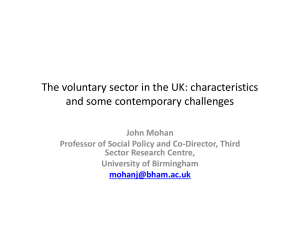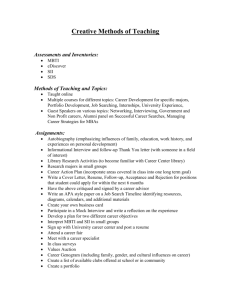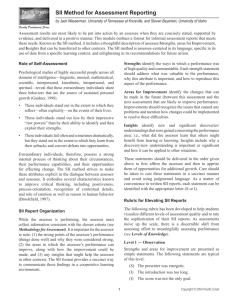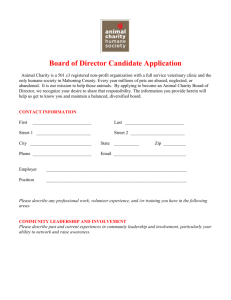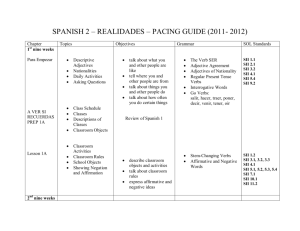Social Impact Investing: An Expert`s View
advertisement
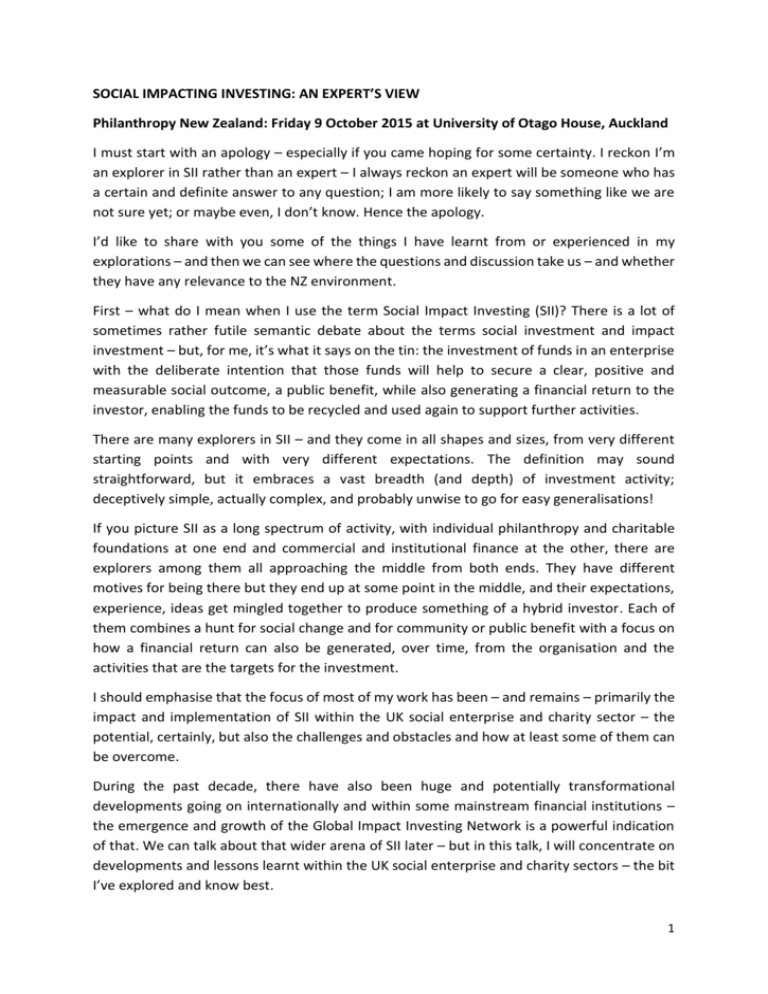
SOCIAL IMPACTING INVESTING: AN EXPERT’S VIEW Philanthropy New Zealand: Friday 9 October 2015 at University of Otago House, Auckland I must start with an apology – especially if you came hoping for some certainty. I reckon I’m an explorer in SII rather than an expert – I always reckon an expert will be someone who has a certain and definite answer to any question; I am more likely to say something like we are not sure yet; or maybe even, I don’t know. Hence the apology. I’d like to share with you some of the things I have learnt from or experienced in my explorations – and then we can see where the questions and discussion take us – and whether they have any relevance to the NZ environment. First – what do I mean when I use the term Social Impact Investing (SII)? There is a lot of sometimes rather futile semantic debate about the terms social investment and impact investment – but, for me, it’s what it says on the tin: the investment of funds in an enterprise with the deliberate intention that those funds will help to secure a clear, positive and measurable social outcome, a public benefit, while also generating a financial return to the investor, enabling the funds to be recycled and used again to support further activities. There are many explorers in SII – and they come in all shapes and sizes, from very different starting points and with very different expectations. The definition may sound straightforward, but it embraces a vast breadth (and depth) of investment activity; deceptively simple, actually complex, and probably unwise to go for easy generalisations! If you picture SII as a long spectrum of activity, with individual philanthropy and charitable foundations at one end and commercial and institutional finance at the other, there are explorers among them all approaching the middle from both ends. They have different motives for being there but they end up at some point in the middle, and their expectations, experience, ideas get mingled together to produce something of a hybrid investor. Each of them combines a hunt for social change and for community or public benefit with a focus on how a financial return can also be generated, over time, from the organisation and the activities that are the targets for the investment. I should emphasise that the focus of most of my work has been – and remains – primarily the impact and implementation of SII within the UK social enterprise and charity sector – the potential, certainly, but also the challenges and obstacles and how at least some of them can be overcome. During the past decade, there have also been huge and potentially transformational developments going on internationally and within some mainstream financial institutions – the emergence and growth of the Global Impact Investing Network is a powerful indication of that. We can talk about that wider arena of SII later – but in this talk, I will concentrate on developments and lessons learnt within the UK social enterprise and charity sectors – the bit I’ve explored and know best. 1 I have spent all my life working within the social sector, in charities, in social housing organisations, social enterprises, arts organisations, foundations, and in specialist intermediary funders; as an employee, a trustee or Board member, as an adviser or consultant. I have not come into SII from financial services or the private sector. In recent years, I have been recruited to be a Board member of two financial institutions, each of which exist to provide SII. One is a Dutch based Bank, Triodos, the largest social bank in Europe, with 11 Billion Euro assets under management, 1000 employees, 650,000 customers; owned by a Foundation but with 34,000 individual shareholders – a Bank that has doubled in size in the last 6 years and has never made a loss. The other, in the UK, is called Big Society Capital, a wholesale funder which will invest £600 Million over the current decade through specialist intermediaries in social enterprises, charities and social purpose organisations. BSC is also charged with working with others to build a social investment market within the UK, a market which will extend beyond the levels of financial return and risk that BSC’s own funds can target. Before I share with you some of my explorations in SII in the UK, I want to start with three quotations, each of which sums up some aspects of what I have been doing and of my approach. The first comes from a disgruntled and frustrated leader of a community organisation, describing her struggles to raise the funds needed to maintain the work she and her colleagues do: “the trouble with so many funders is that they provide the wrong sort of money.” The second came from a talk I gave to an audience of staff of charities and social enterprises when I was asked to set out what I thought were the key priorities any charitable foundation should aspire to: I said number one was “Do No Harm.” To my surprise, the statement got a huge round of applause – I discovered later this stemmed from a total misunderstanding within the audience about what I was driving at. I meant it to be a plea for foundations to align and connect their investment strategies to their charitable mission – to ‘do no harm’ to their mission with the investments made from their endowments. The audience ‘heard’ the exhortation completely differently as being a plea for foundation grant-making practice to serve the mission rather than the administrative convenience, compliance requirements or prejudices of the foundation. The third quote comes from a former work colleague in the UK, Julia Unwin, who now runs the Joseph Rowntree Foundation. In her splendid book, the Grant Making Tango, she says there is a danger of funders’ enthusiasm for impact measurement, becoming a “frequently absurd pseudo-science, a misguided attempt to quantify the abstract, an issue that has been over-intellectualised, made too complicated and been confused with notions of numerical measurement.” More recently the current President of the Ford Foundation echoed this when he said that "Our sector’s obsession with quantifiable impact, and frequently dogmatic adherence to discrete deliverables, undercuts the expansive purpose of [civil society organizations], miniaturizing them in their ambition. In other words, this system is rooted in 2 transactional short termism — a tyranny of donors — that distorts and inhibits, rather than unleashes, the potential of civil society." All rather negative stuff – (not least that last one as impact measurement is such a central feature of SII). But I suggest they are all important warnings if we are to explore how SII can be a positive asset and enhancement for the social enterprise and charity sectors. My explorations have reflected the sentiments expressed in these quotes in efforts to try: To ensure that organisations have access to ‘the right sort of money’ – appropriate to what they are trying to do, to the stage of their growth and development, and to their capacity and resilience To persuade trustees of charities, and especially of those with endowments, to use all their resources to support their mission and not to allow , for example, invested assets to undermine or ‘to do harm’ to their charitable purposes, the reasons they were setup in the first place To help organisations (and their funders) to manage themselves with clarity of purpose and outcomes, to gather data about their work which is useful and appropriate, so that they can monitor and reflect on how they are doing, apply the lessons being learnt – and share that learning. The three quotes are also important for me because they are all about the behaviour of funders – none are about what activities a donor, a foundation, a social investor chooses to support; they are about the processes, systems and types of funding those supporters of civil society choose to adopt when deciding to provide funds. It is the behaviour of funders that has preoccupied me throughout my career – and still does – and that has been at the heart of my exploration of SII. To illustrate this, I’ll pick out what I regard as 5 key points in my explorations – some lessons learnt in practice which have subsequently influenced what I have tried to do. The first is from my very first job, at the end of the 1960’s, helping to run a tiny organisation that worked with what were then called ‘delinquent youth’ in Yorkshire. We were a classic small charity, (typical of those times but also of current times, too) surviving from year to year on a mixture of donations, grants, gifts, sales and good-will; a ‘money in-money out’ enterprise spending what we had, undercapitalised and over stretched; with no reserves and certainly no resources to finance expansion or growth. Then the roof of our building sprang a leak – we could not continue our work with a hole in the roof; our survival was threatened. It never occurred to us not to do what we did, which was to go and see our local bank manager, someone we knew well, and we borrowed the £1,750 needed to mend the roof and keep our work going. The loan was unsecured – we did not own our building and almost none of our income was guaranteed; but he knew us, he trusted in our ability to raise and repay the funds over the three year term of the loan – and we did. 3 In more recent decades, there would have been no local bank manager to talk to, a loan application would have been considered by a computerised system and rejected as we were an unincorporated charity, unable to provide any security or revenue certainty. In those days, when facing a cash loan crisis, my trustees did not say, as I fear they might have done 20 or 30 years later, we cannot use debt to keep the charity going. In the UK, over those three decades, charity trustees have developed an aversion to debt, fuelled by a culture within the sector and among fundraisers that the ‘menu’ of funding options is all about donations, legacies, grants – ‘money in and money out.’ Such a financial model is flawed and renders the charity’s mission fundamentally vulnerable. SII can be a valid and valuable addition to those options, even for small amounts. Next, when working in social housing in the 70’s and 80’s, I was part of efforts to develop funding arrangements for special needs housing schemes which combined, for the capital finance needed to build the housing, grants from the public sector and loans from the private sector; and revenue finance which combined grants, subsidies, from the public sector, charges to our residents, our customers, and donations from philanthropists, foundations and corporate donors. Different types (and sources) of finances being blended together to produce and to maintain new developments and services – and to purchase or create assets which in turn could be used as security to help the organisation expand further. For me, this was practical experience of how subsidy and loans could be made to work side by side to achieve more than either could have done on their own. Next I worked for a specialist funding intermediary – packaging up funds raised from large foundations and institutions to allocate to small community organisations serving homeless and badly housed people. We added value (I hope) to the transactions (and justified the provision to us of the funding) by the work the staff did to help the community based organisations acquire and develop the capacity, skills and organisational resilience to become high quality service providers – something the large foundations did not have the skills, time or staffing to provide. Over 70% of the funds we allocated went out as loans, very patient in terms with no repayment required for several years. Given we had very few bad debts, the grants made to us, the intermediary, by the big generalist foundations, were subsequently recycled as the loans they were used for were repaid and the funds could then be used time and time again. This experience confirmed for me the vital role that specialist intermediaries can play within a funding eco-system and the potential, in the right circumstances, for patent loan finance, even for small social enterprises and charities. Next I went to work for one of those big generalist foundations and became caught up in funder behaviour which I think, now, significantly weakened and distorted the financing of much of the UK charity sector. For all sorts of good reasons, that foundation, like 99% of other funders at the time, provided what we call ‘restricted’ grants – grants targeted at the support of specific activities (rather than at the general support of the organisations that had asked 4 for the money). Grants, what’s more, that tended to be processed, allocated and managed in perverse ways. We had caught the disease of ‘project-it-is.’ Like many foundations and philanthropists and corporate funders in the 1990’s: • we expected the charities to which we made grants to achieve complex project goals and social change within a very limited period of funded time. All involved, I suspect, in our hearts, knew the funding period was not long enough for them to be fully attainable; • we tended to underfund the proposed level of work and, especially, to underfund the essential operational running costs of the organisations without which the specific project we had chosen to support would probably not be adequately managed; • we imposed transaction and compliance costs (on ourselves as well as on those we funded) which were disproportionate to the scale of the funding and which added burden not value to the transaction; • we colluded with a situation where too many organisations that were hunting for funding felt that they had to reshape their description of what they are trying to do in order to meet my foundation’s enthusiasms and criteria – a process that can all too easily lead to a distortion of an applicant organisation‘s mission as, desperate for funding, they feel obliged to “bend too willingly in whatever direction money is blowing.” In many cases, therefore, we were providing ‘the wrong sort of money.’ We were a foundation that was commended at the time for its transparent and comprehensive reporting – we published details of every grant and what it was intended to support – this at a time when the detail of the work of many funders was often almost invisible. However, if my trustees, or anyone outside the foundation, had asked us if we could tell them about the impact of our funds – had our grants helped anyone actually achieve some lasting and positive change? – we would have struggled to answer except through anecdote. We were great on reporting the outputs, how many people had attended this centre or had been through this programme – but we had no real data or knowledge of what were (if any) the outcomes or lasting achievements of the work we were supporting. In addition, we were not systematically searching out or analysing the lessons learnt that could be applied in the future by ourselves in considering new applications or by other organisations interested in a particular type of initiative. We had no useable measurements of lasting impact or of progress towards such impact. We did eventually realise some, at least, of the down-sides of our behaviour as a funder. We abandoned project grants and introduced longer term grant programmes to support ‘core costs’ – to help organisations build up greater resilience, stronger governance, an ability to plan ahead, to make use of development capital. We began to talk about outcomes and impact, not just outputs. And we began to look beyond grants – to explore our convening and commissioning potential, the power and the value of the learning derived from what we were supporting (lessons learnt about what to avoid in the future as well as what to emulate). And we began to test out how our resources, including some of our funds, could be used alongside 5 our grants to enable organisations to grow more quickly, to take on more ambitious tasks, to be freed up to drive forward without constantly having to fit into funder imposed ‘boxes’. We began to explore how charitable foundations and philanthropic funds could be used to make SII. None of this looks now like rocket science – but, in the 1990’s, in the UK, funding systems based only or mainly on restricted grants were the standard norm – leading, I think, not only to what one commentator described as a ‘dance of deceit’ between fund seeker and fund provider, but also to a very limited ‘menu’ of funding options which did not enable the full potential or talents of the charity and social enterprise sector to flower or to become sustainable. You may be wondering what this has all got to do with SII in 2015 – bear with me on this! One of the lessons learnt, certainly in the UK, is that changing the behaviour of both funders and fund seekers is a tough task – the ‘culture’ of the ‘money in-money out’ model is deeply rooted on both sides of the funding transaction. Grant making is seen as the essential, indeed almost the only, tool or financial instrument available. Grants are – and always will be – an essential part of the funding mix. But they are a limited and precious resource and are also not the only way of getting funds from A to B. Their terms can sometimes be restrictive rather than enabling, and their impact can be enhanced by being linked with other forms of finance and support. On their own, they are not always the ‘right sort of money.’ That became increasingly apparent at the beginning of the last decade as we established in the UK the Social Investment Task Force, the fifth of my key exploratory steps. This Government initiated group was intended to look at how to address the persistent and unrelenting poverty and lack of financial opportunity in the poorest 25% of UK communities. I think initially the private and public sector people involved in the Task Force reckoned that, if they just got their sectors better geared up to address that poverty, they would sort it out – but they quickly they realised that civil society, community groups, social enterprises and philanthropic funds were not only essential to addressing these challenges but likely to be the main sources of initial impact and levers for change. The Task Force led to the creation of the first social venture funds in the UK, to the recognition that specialist intermediary pooled funds were needed to engage with those communities and get funds appropriately routed to them, to the introduction of the first tax relief scheme to incentivise social investment, and to the first steps on encouraging foundation and philanthropic funds into social investment. The latter has involved getting the charity regulator and law commission to clarify and confirm that it is OK for charitable funds to be used for SII. It has also led to extensive and often frustrating efforts to challenge the orthodox views of charity trustees about what is their fiduciary duty and the deeply held and institutionalised attitudes among charity investment managers and advisers that there can be no connection between investment strategies and charitable mission. 6 The work and influence of the Social Investment Task Force led eventually to the formulation of proposals to set up what is a wholesale social investment ‘Bank’ – Big Society Capital: BSC. This finally came into being 12 years after the Task Force reported. It is charged not only with investing capital resources in intermediary funds that can then in turn provide investment finance direct to social enterprises and other social purpose organisations but also with working right across that spectrum of funding that I mentioned earlier, to build a social investment market within which lots of differently motivated suppliers of SII can support a diversity of enterprises, some directly and some through specialist intermediaries. It’s important to emphasise that, for some organisations, any form of social investment may be inappropriate, even harmful. Moreover, the investment needs of the enterprises that may be able to make effective and productive use of SII vary a lot. Some are not yet ready for SII but have the potential to be ready to use such funding in the future – they need grants and help with capacity building to reach a stage when investment in their development is feasible. Some require a combination of subsidy and investment. Some will be able to return invested capital but not necessarily to deliver more than that. Some can generate financial returns at all levels up to and including what might be described as market returns. But all deliver public benefit, social returns that can be measured or at least can show indicators of success, to provide genuinely ‘blended value.’ All are part of the SII market. Some of the funds will always be philanthropically driven – the social impact being the absolute priority and the investors, usually foundations, other charities or individual philanthropists, being willing to convert some or all of their investment to a grant if that turns out to be the price that has to be paid for the full social impact being achieved. Other investors will be happy to get their capital back to reuse to support other initiatives but will not be worried if the investee can pay back no more than that. Some other funds are built round community shares, community assets financed from within the beneficiary community. Others are accessible to mass market investors, retail funds or charity bonds demonstrating that SII is not just the preserve of ‘the big rich boys’ or of foundation and institutional investors. Other funds are bringing mainstream financial institutions and local authority pension funds into the fray, working in partnership with non-profit organisations and are beginning to regard these investments as an extension of their standard portfolio. Some are place based investment funds. Some are testing innovative funding instruments for supporting public service delivery through Social Impact Bonds or other forms of results based finance. Some are exploring whether it is possible to develop (and fund) mission locked social purpose organisations that are privately owned. All are part of the SII market. So far, in less than 3 years, BSC has committed £162 million of its own funds which have been more than matched by £208 million from a variety of partners who have joined with us. Over 35% of that money has already been paid out to the intermediaries who then make the investments in individual enterprises. 7 Important though I argue the work of BSC is to the funding of the social sector, many of the financial instruments and deals it is testing are complex and innovative – and expensive. It is worth noting that straightforward secured loans remain the biggest form of SII in social enterprises and social businesses – the UK Triodos branch, for example has a loan book totalling over £550M. So – much is changing in trying to ensure that the ‘right sort of money’ is available to the social sector in the UK and that charities use more of their assets to support SII and the ability of organisations to access it. It’s no longer just exhortation and rhetoric. Actual transactions are happening, real deals are being implemented, pipelines of demand are growing – never as fast as the more impatient of us would like, but the use of various forms of SII is gaining momentum. There are many reasons for the success of these developments and many lessons have been learnt, some very painfully. Here are four: Time and Patience My exploration has been over 45 years. Big Society Capital emerged 12 years after the UK Social Investment Task Force reported. Social policy change is hard work, a long grind; it needs champions with stamina and determination. They must not preach or prescribe – you can’t force a market into existence. The cultural obstacles within charities and within the financial services sector are very deeply rooted. Even now, the orthodoxy is very powerful and dominant. And, even when the money and the infrastructure are in place, individual SII transactions take time – work leading to a commitment may have taken many months of preparation and negotiation; many more months may pass before money actually flows; and months, probably years, will pass before the lasting social impact of that investment can be accurately assessed. Momentum is increasing but it’s an immature market with an embryonic infrastructure within which almost every transaction has been ‘the first of its kind.’ The Silo Challenge There is a tendency throughout the world for individuals and institutions and professions to work in silo’s – or rigid boxes – to stay within tightly defined boundaries. SII is an absolute challenge to that – it depends on the world of investment and finance working in partnership and engaging mutually with the social enterprise and charity sectors; to replace the Binary ‘Either/Or’ with the ‘Both/And’ blended approach That makes it all the more important that the advocates of SII report vividly and accurately about the outcome of their efforts – and demonstrate the mutual gain that each can secure while also generating positive social impact and public good. That’s one reason why impact measurement is so vital – one reason, too, why I chair Inspiring Impact in the UK, a collaboration between charities, social enterprises and funders to help get impact measurement into the blood stream, the DNA, of all organisations. 8 Good impact measurement has to be good management practice – why would you want to work in (or help with funds) an organisation that was unable to set out clear outcomes and performance targets which a particular function or new project is intended to deliver unable to be clear in advance about the steps that it will take to achieve those targets unable to take stock as each step is completed and to be ready to adjust or amend the targets/timetable/methods if experience and learning demonstrate that to do so would be appropriate? Good, purposeful and inspirational management (and the effective use of resources) depends on such measurement being at the heart of any organisation – especially so if it is trying to address a tough social challenge or assist an underserved community. It is unfortunate that, certainly in the UK, inappropriate or excessive funder demands for ‘impact measurement’ have tainted the data gathering and learning that ought to be a central feature of any well managed organisation. Fiduciary Duty We are already seeing significant changes in various parts of the world in how charity trustee fiduciary obligations are interpreted – and I believe this will accelerate. In the UK, the orthodox definition of fiduciary duty has been concerned solely with financial risk and return. Prudence has been focused only on financial return being balanced by an acceptably comfortable level of risk. Whether the invested funds are being used inconsistently with the values or purposes, the achievement of the long-term mission of the investor charity has tended to be ignored or given little attention. But, as the recently published report ‘Intentional Investing’ asserts: “Charity trustees (in the UK at least) are obliged to use their resources in ways that best meet their charitable objectives; charity trustees are not obliged to pursue investment returns at the expense of their charitable mission, their organisation’s reputation, or in ways that could alienate donors or beneficiaries.” Role of Government Finally, Government. The involvement of government (of both political persuasions) has been critical to what has been built in the UK – very few of the initiatives I have described could have happened without some direct government involvement. But Government can be both a help and a hindrance; indeed in the UK we have found they can be both at the same time – the actions of one part of government sometimes proving to be an unmovable obstacle to the aspirations of another. Government also finds it difficult to be patient – and SII is definitely a patient form of capital. Government timetables tend to be short term. Government tends to rigidity and likes things to be defined, to set firm boundaries, to get anxious about flexibility. Government behaviour can make or break the successful building of a SII market. Such a market will always be a bit 9 messy and untidy – littered with things that didn’t work as planned, gaining much from luck and serendipity and from individual entrepreneurial brilliance that is seldom easy to emulate – that’s the nature of entrepreneurial energy. We have been lucky in the UK (so far) that successive governments have encouraged and enabled the emergence of SII, have helped ensure the rules are not crazy or contradictory; but they have kept away from handling actual investment transactions – and have not appeared to worry too much if not everything in the market is neat and tidy. Conclusion SII is not a magic bullet, and it’s important that it is not presented as such. It is, however, a valid and potentially valuable addition to the range of financing options that many social sector organisations can, at various points in their development and growth, make good use of – and in so doing can generate a return to the institutions and people that wish to be social investors. It needs adventurous pioneers with stamina and perseverance who can also be inspirational advocates, describing vividly what is possible but avoiding hyperbole. It’s important that people don’t get hooked on the detail of the various financial tools or on the ingenuity of those creating them. They are only valid and worth the effort if the resources they generate can be used effectively to achieve changes of real impact in individual lives and community well-being. That’s what my exploration has helped me get a bit of a handle on – to try always to get the ‘right’ sort of money at the ‘right’ times to organisations that are equipped and able to use those funds to achieve great performance outcomes and social impact. David Carrington October 2015 10
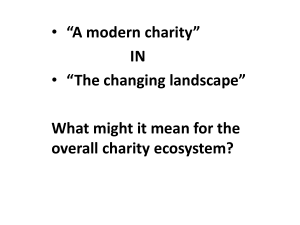
![[SII] Observations and what they tell us](http://s2.studylib.net/store/data/005777176_1-4007393d604d028757bc9097e7c6881d-300x300.png)
